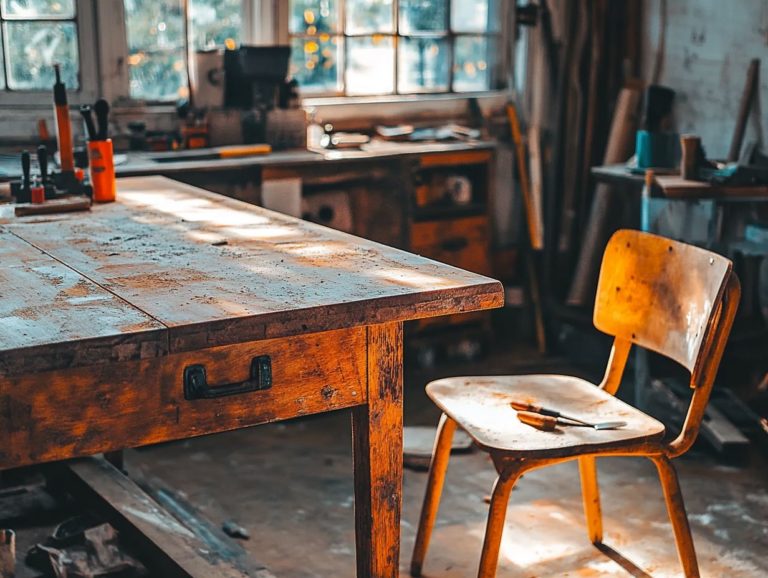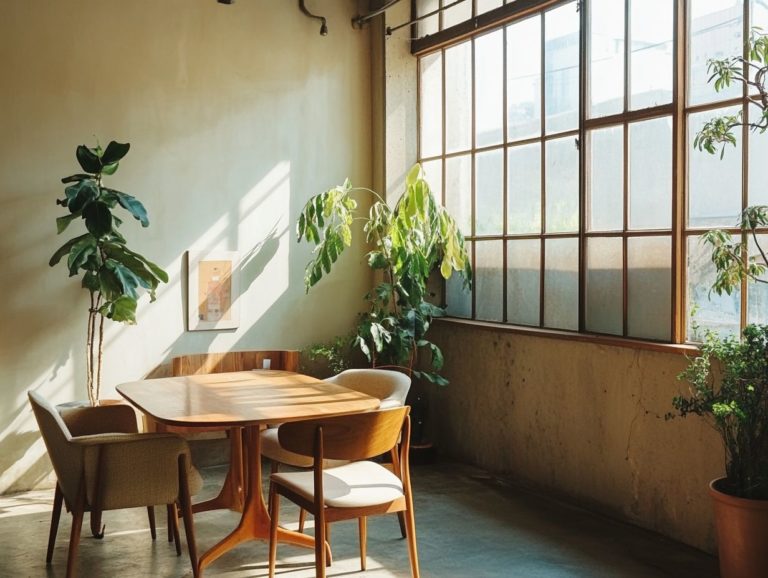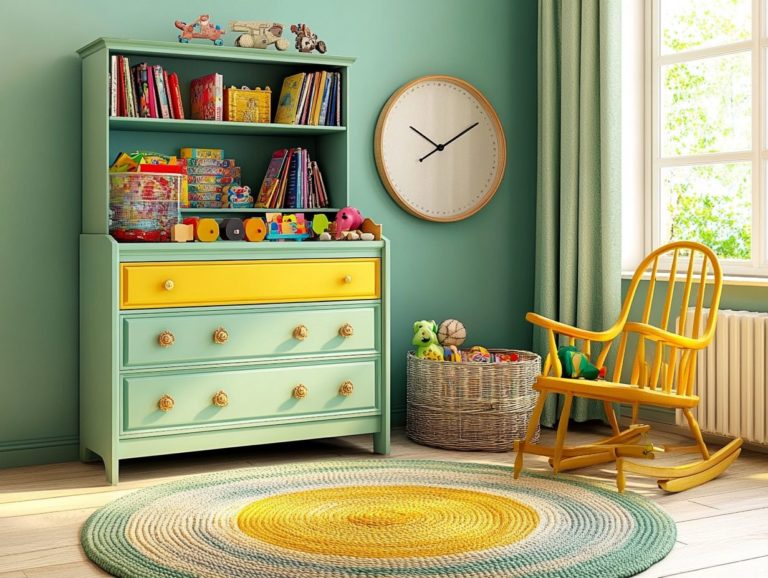5 Essential Maintenance Tips for Vintage Furniture
Vintage furniture infuses any space with charm and character, yet it requires special care to preserve its beauty and integrity.
Here are five essential maintenance tips to protect your cherished pieces, from regular dusting to avoiding direct sunlight.
Discover how to identify and date vintage furniture, understand the most common types and materials, and assess its value.
Whether you re a seasoned collector or a casual enthusiast, this guide empowers you with the knowledge needed to preserve your vintage treasures for years to come.
Contents
- Key Takeaways:
- 1. Regular Dusting and Cleaning
- 2. Avoid Direct Sunlight
- 3. Keep Away from Heat Sources
- 4. Repair Any Damage Immediately
- 5. Use Appropriate Cleaning Products
- How to Identify and Date Vintage Furniture?
- What Are the Most Common Materials Used in Vintage Furniture?
- How Can One Determine the Value of Vintage Furniture?
- What Are the Benefits of Owning Vintage Furniture?
- How Can One Properly Store and Display Vintage Furniture?
- Frequently Asked Questions
- What are the 5 essential maintenance tips for vintage furniture?
- Why is regular dusting important for vintage furniture?
- How does direct sunlight affect vintage furniture?
- Can any cleaning products be used on vintage furniture?
- Why is it important to keep moisture levels in check for vintage furniture?
- Should damages to vintage furniture be repaired immediately?
Key Takeaways:
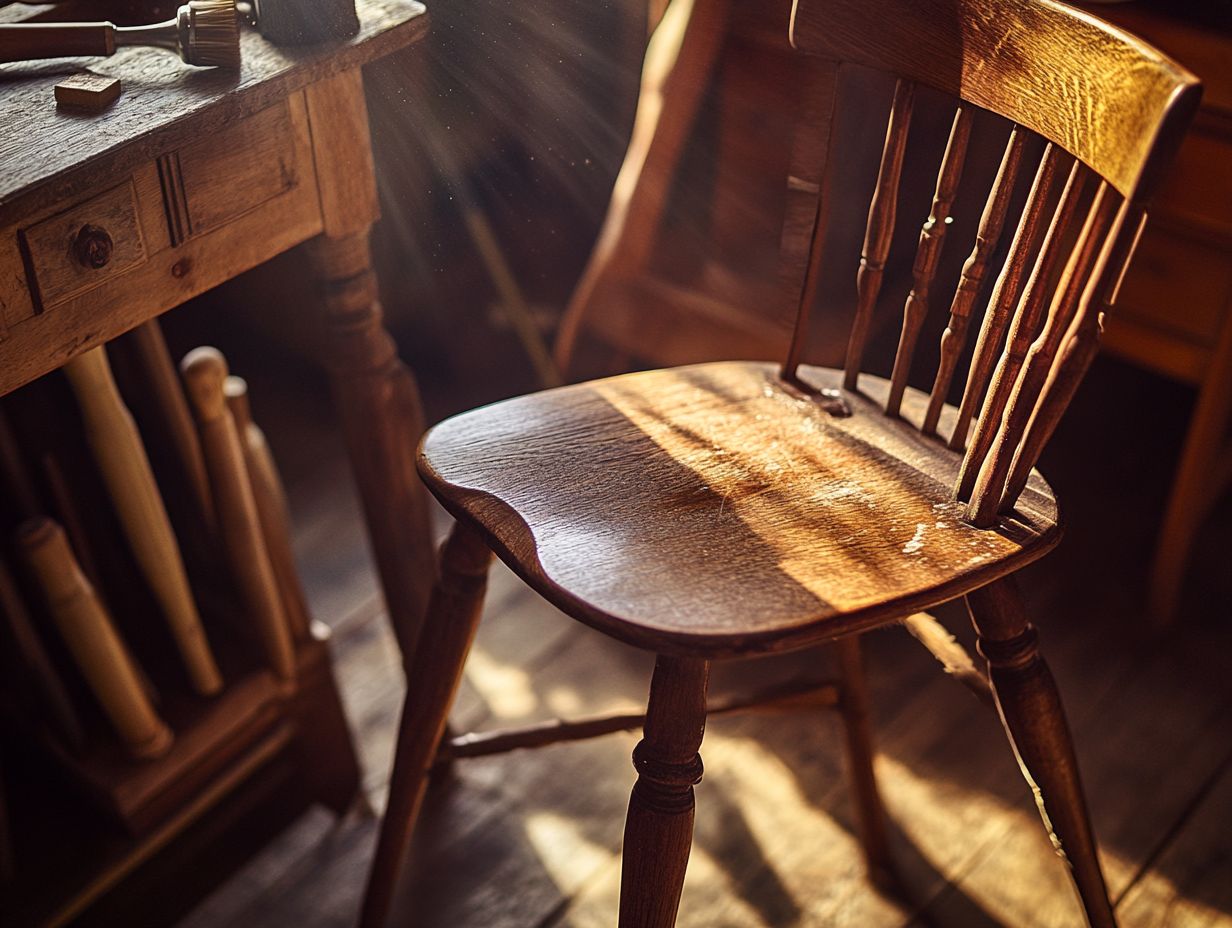
- Regular dusting and cleaning are essential for maintaining the appearance and longevity of vintage furniture.
- Keep your furniture safe avoid direct sunlight and heat sources that can cause damage.
- Immediate repairs are a must to prevent further damage!
1. Regular Dusting and Cleaning
Regular dusting and cleaning are crucial for maintaining the beauty and longevity of your antique furniture. These cherished pieces need care to remain in excellent condition for generations.
Learn about antiques and use a soft or microfiber cloth to gently wipe away dust. This method prevents scratches and preserves the delicate surfaces of your prized items.
Routine maintenance enhances their aesthetic appeal and mitigates the effects of accumulated dust and dirt, which can lead to deterioration over time.
Establishing a cleaning schedule can significantly benefit the care of these treasures. Incorporate weekly dusting and monthly deeper cleanings into your routine. Use pH-balanced cleaners, which are safe products that won’t harm wood finishes, and avoid harsh chemicals.
Regular inspections will help you spot potential issues like moisture or pest damage before they escalate.
If you’re uncertain about your cleaning methods, consider hiring professionals who specialize in antique care. They ensure your precious furniture receives the meticulous attention it deserves for preservation while also enhancing its value.
2. Avoid Direct Sunlight
To preserve the integrity of your antique furniture, avoid direct sunlight. Over time, exposure can lead to fading and weakening of both the wood and upholstery fabrics.
This deterioration detracts from the aesthetic appeal and diminishes the overall value of your cherished pieces. Thankfully, you can take several strategic steps to protect your antiques.
For example, use UV-blocking window treatments to reduce harmful exposure while still allowing a gentle glow of natural light to fill your space. Position your furniture away from direct sunlight perhaps in rooms with less exposure or behind sheer curtains to help safeguard their longevity.
Regular care is crucial. Dusting with soft cloths and applying appropriate wood conditioners will ensure that the original beauty of these historical treasures shines through, allowing them to stand the test of time.
3. Keep Away from Heat Sources
Keeping antique furniture away from heat sources is vital for preserving its condition. Excessive heat can lead to warping, cracking, and various forms of damage that compromise both its beauty and structural integrity.
To create a stable environment for these cherished pieces, avoid direct contact with radiators, fireplaces, and air vents. Be mindful of furniture placement near these hazards.
Use protective furniture pads or cushions to add an extra layer of defense against temperature fluctuations. You may need to relocate furniture to a cooler area of the room to ensure its longevity.
By taking these precautionary steps, you can guarantee that your antiques remain as stunning and functional as the day you first acquired them, especially if you follow a step-by-step guide to restoring vintage furniture.
4. Repair Any Damage Immediately
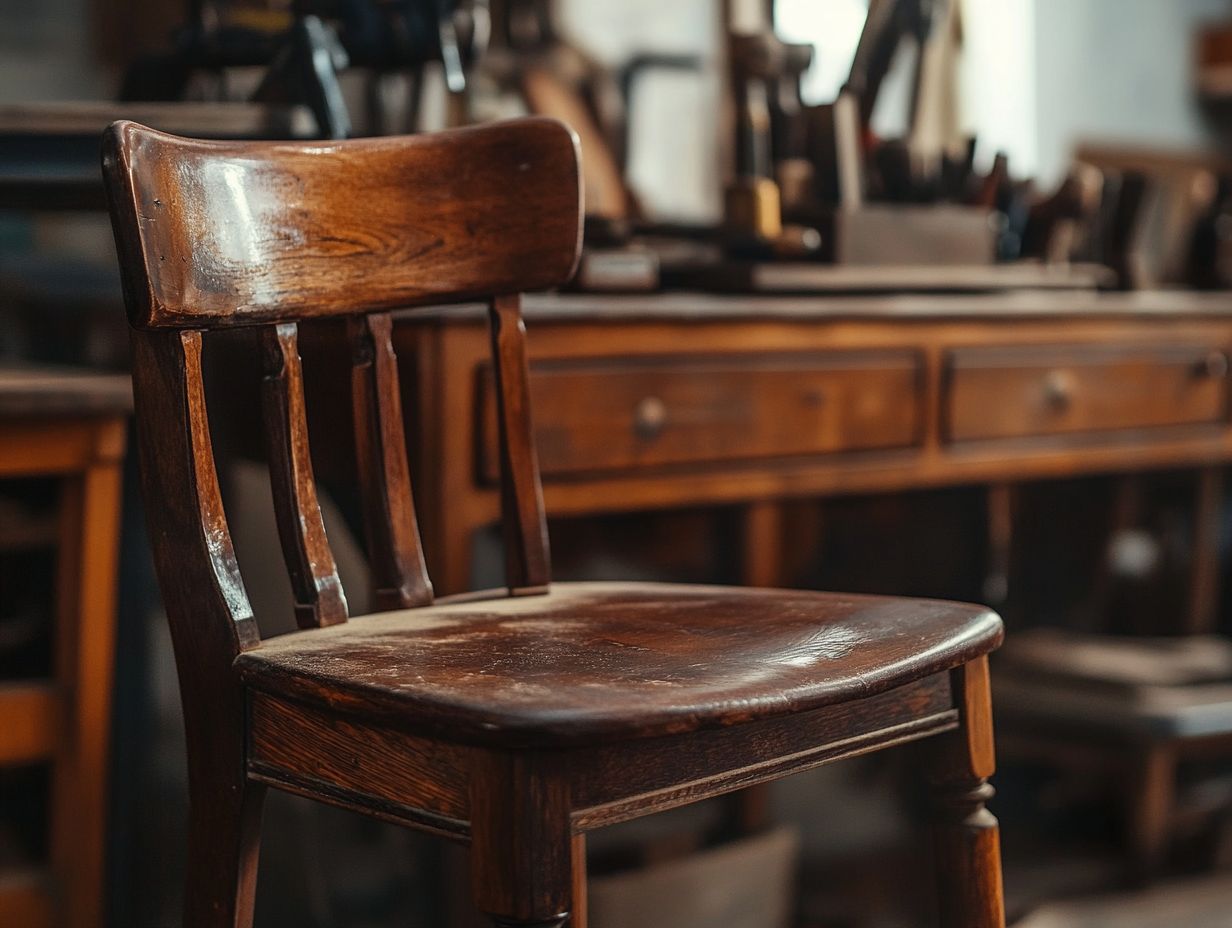
Every scratch tells a story, but it s up to you to preserve the tale! Immediate attention to any damage on your antique furniture is essential for preserving its value and beauty. Timely repairs prevent further deterioration and maintain the historical value of these cherished pieces.
Types of damage can include scratches, water stains, and structural issues. Regular assessments are vital to spot early signs of wear that might slip under your radar.
While minor fixes, like applying wood polish or filling small scratches, can often be tackled at home, more extensive repairs may necessitate the expertise of a qualified furniture expert. Consulting with an expert ensures correct restoration and protects the piece’s authenticity and value for future generations.
5. Use Appropriate Cleaning Products
Choose the right products now to protect your treasures before it’s too late! Using the right cleaning products is crucial for caring for your antique furniture. Harsh chemicals can inflict irreversible damage on the wood and fabric, compromising their beauty and historical value.
To preserve these cherished treasures, opt for cleaning solutions specifically designed for delicate materials. For antique wood, a gentle blend of warm water and a few drops of mild dish soap can effectively lift dirt without stripping the finish. For more detailed guidance, consider following how to care for antique and vintage wood furniture. In terms of upholstery, a solution of equal parts water and white vinegar works wonders for neutralizing odors and stains.
It’s wise to test any cleaning solution on a small, inconspicuous area first to ensure it doesn t alter the color or texture. Applying these products with a soft, lint-free cloth allows you to achieve a thorough yet safe cleaning process.
How to Identify and Date Vintage Furniture?
Discovering the history of vintage furniture is an exciting adventure that enhances your appreciation and its value. By understanding antique furniture history and employing specific strategies, you can uncover details like style, craftsmanship, and materials that define various periods. Consulting with professionals can provide invaluable insights that further enrich your exploration.
Several techniques can aid you in this discovery process. Examining construction methods is essential. For instance, dovetail joints a type of joint used in furniture making often indicate the high-quality craftsmanship typical of certain eras. Recognizing specific materials, like oak or mahogany, along with understanding design styles from Art Deco to Mid-Century Modern can offer further clues about a piece’s origin.
Utilizing resources such as online databases, antique guidebooks, and catalogs can be immensely beneficial as you delve into vintage furniture. Additionally, discovering must-have vintage furniture pieces for collectors can enrich your collection. Connecting with antiques experts through workshops or online forums can illuminate nuances that are often overlooked, enhancing your overall experience and knowledge of these cherished artifacts.
What Are the Most Common Types of Vintage Furniture?
The world of vintage furniture is a treasure trove of styles and types, each exuding its own charm and historical significance. As a collector, knowing these styles is crucial.
From the ornate carvings of Victorian pieces to the sleek lines of mid-century modern designs, each style narrates a story reflective of its era. These unique pieces are not just functional; they re rich with stories waiting to be shared. For instance, the intricate detailing of baroque furniture showcases the craftsmanship of a time when artisans poured their heart and soul into every creation.
Proper maintenance of these vintage gems is crucial. Using a gentle cleaner for wood surfaces helps preserve the integrity of the finish, while steering clear of direct sunlight prevents fading. Incorporating essential pieces of vintage furniture into your decor can enhance the charm of your space. By taking meticulous care of these treasures, you ensure that your investment not only retains its beauty but also appreciates in value over time.
What Are the Most Common Materials Used in Vintage Furniture?
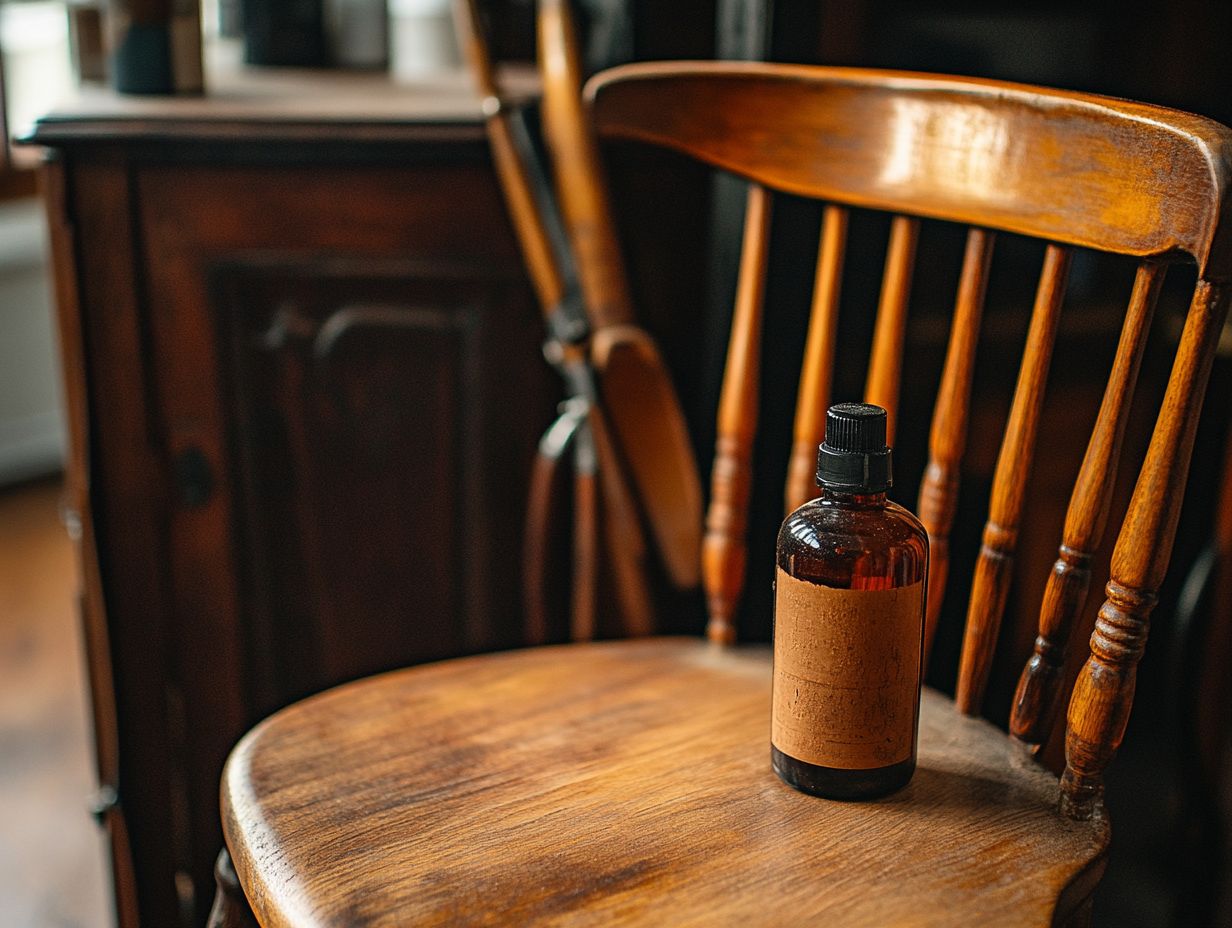
Vintage furniture is a captivating blend of materials. Each contributes to its unique allure and durability. As a vintage furniture owner, it’s important to know what makes these pieces special.
Among the most prevalent materials are hardwoods like oak, walnut, and mahogany. Each is known for its remarkable strength and beauty. Then there are veneers delicate slices of wood glued onto core panels. They add visual depth and intricate designs while conserving precious resources.
Upholstery fabrics such as leather, velvet, and cotton enhance your comfort. They also reflect the style of the era in which the piece was crafted.
Proper maintenance is key. For antique wood, wipe it gently with a damp cloth. Occasionally polishing with wax will help maintain its luster. You should apply protective finishes and store your treasures in climate-controlled environments, meaning regulated humidity and temperature, to preserve their integrity and timeless charm.
How Can One Determine the Value of Vintage Furniture?
Determining the value of vintage furniture involves several factors, including craftsmanship, condition, and market demand. It’s a nuanced task that often benefits from expert insights.
Additionally, elements like provenance the history of ownership of a piece and rarity can significantly enhance its worth. A thorough appraisal needs a keen eye for detail. You should also understand the historical context and current market trends.
If you’re considering selling your vintage items, consulting with an antiques expert is essential. They ensure your assessments are accurate and comprehensive.
These specialists can offer valuable insights into pricing strategies and how to showcase the unique qualities of each piece. This ultimately leads to a more successful sale. Take high-quality photographs and document any prior restorations to enhance the furniture’s appeal to potential buyers.
What Are the Benefits of Owning Vintage Furniture?
Owning vintage furniture offers a wealth of benefits that goes beyond mere decoration. The unique beauty, historical significance, and potential for value appreciation over time make it a truly worthwhile investment.
These vintage pieces bring undeniable charm. They can elevate the aesthetic of any room, infusing your space with warmth and sophistication. Their eclectic designs serve as focal points, sparking engaging conversations among guests.
By curating these items, you express your personal style. You can blend historical allure with modern sensibilities. As sustainability becomes a priority for many homeowners, vintage furniture stands out as an eco-friendly choice. It also holds the promise of future value appreciation, making your selections not just visually stunning but also a financially wise decision.
How Can One Properly Store and Display Vintage Furniture?
Proper storage and display of vintage furniture are essential for preserving its condition and beauty. Neglecting this can lead to deterioration and a significant loss of value over time.
To create the ideal environment for your treasured pieces, it’s vital to control the climate. Keeping temperature and humidity levels consistent will help prevent warping, cracking, and mold growth, ensuring their longevity.
Using protective measures like furniture covers can safeguard delicate surfaces from dust and scratches. When displaying these unique items, choose lighting that accentuates their distinct features without causing harm.
Avoid direct sunlight, as it can fade colors over time. Instead, opt for adjustable shelving that provides adequate space between pieces. This enhances visibility and airflow while minimizing the risk of accidental damage.
Frequently Asked Questions

Act now to preserve your vintage treasures! Explore your pieces more thoroughly or seek expert advice to ensure they remain in pristine condition.
What are the 5 essential maintenance tips for vintage furniture?
The 5 essential maintenance tips for vintage furniture are: regular dusting, avoiding direct sunlight, using the right cleaning supplies, keeping moisture levels in check, and promptly repairing any damages.
These steps are crucial for preserving the beauty and longevity of your vintage pieces.
Why is regular dusting important for vintage furniture?
Regular dusting prevents dirt and grime buildup on vintage furniture. This practice helps maintain the original shine and finish, keeping your pieces looking great.
How does direct sunlight affect vintage furniture?
Direct sunlight causes fading, discoloration, and even warping. Keep your furniture away from windows or use curtains to limit exposure.
Can any cleaning products be used on vintage furniture?
No, use only cleaning products designed for vintage furniture. Harsh chemicals can damage the delicate finish and wood.
Why is it important to keep moisture levels in check for vintage furniture?
Too much moisture can cause wood to swell or rot. Keep humidity consistent to protect your pieces and maintain their beauty.
Should damages to vintage furniture be repaired immediately?
Yes, address damages quickly to prevent them from worsening. Prompt repairs help maintain the value and integrity of your vintage piece.



